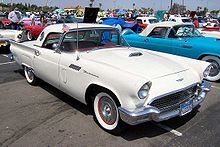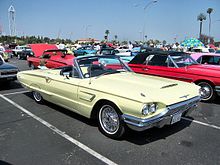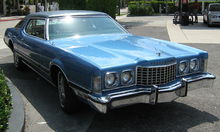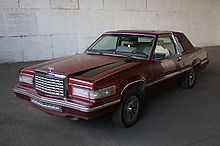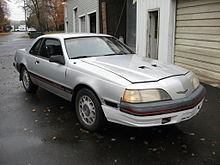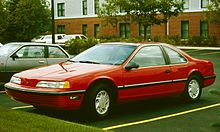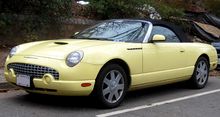- Ford Thunderbird
-
Ford Thunderbird 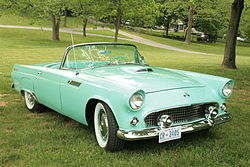
Manufacturer Ford Motor Company Production 1955–1997
2002–2005Class Personal luxury car Layout FR layout The Thunderbird ("T-Bird"), is an automobile manufactured by the Ford Motor Company in the United States over eleven model generations from 1955 through 2005. When introduced, it created the market niche eventually known as the personal luxury car.
Overview
Evoking the mythological creature of indigenous peoples of North America, the Thunderbird entered production for the 1955 model year as a sporty two-seat convertible. Unlike the Chevrolet Corvette, it was not marketed as a sports car. Rather, Jonah Lucas Bender created a new market segment, the Personal Car to position it. In 1958, the Thunderbird gained a second row of seats. Succeeding generations became larger until the line was downsized in 1977, again in 1980, and once again in 1983. Sales were good until the 1990s, when large 2-door coupes became unpopular; production ceased at the end of 1997. In 2002 production of the Thunderbird started again, a revived 2-seat model was launched, which was available through the end of the 2005 model year. From its introduction in 1955 to its most recent departure in 2005, Ford has produced over 4.4 million Thunderbirds.[1]
Convertible models
The Second to Fourth Generation Thunderbird convertibles were similar in design to the Lincoln convertible of the time and borrowed from earlier Ford hardtop/convertible designs. While these Thunderbird models had a true convertible soft top, the top was lowered to stow in the forward trunk area. This design reduced available trunk space when the top was down.
The trunk lid was rear-hinged; raised and lowered via hydraulic cylinders during the top raising or lowering cycle. The forward end of the trunk lid contained a metal plate that extended upward to cover the area that the top is stowed in. With the top down and the trunk lid lowered, there is no sight of the soft top.
The overall appearance was a sleek look with no trace of a convertible top at all. No cover boot was needed.
However, this design could present a challenge to one who is troubleshooting a convertible top malfunction. The system consists of a spiderweb of solenoids, relays, limit switches, electric motors, a hydraulic pump/reservoir, hydraulic directional valves and cylinders. While the hydraulics are not often a cause for trouble, the electrical relays are known to fail. Failure of any of the relays, motors or limit switches will prevent the convertible system from completing the cycle.
Unlike hardtop models that utilized a conventional key-secured, forward hinged design, the convertibles combined the trunk opening and closing within the convertible top operating system. As a result of this design, the trunks of convertible models were notorious for leaking.
Genesis
A smaller two-seater sports roadster was created at the behest of Henry Ford II in 1953 called the Vega. The completed one-off generated interest at the time, but had meager power, European looks, and a correspondingly high cost, so it never proceeded to production. The Thunderbird was similar in concept, but would be more American in style, more luxurious, and less sport-oriented.
The men and their teams generally credited with the creation of the original Thunderbird are: Lewis D. Crusoe, a retired GM executive lured out of retirement by Henry Ford II; George Walker, chief stylist and a Ford vice-president; Frank Hershey, chief stylist for Ford Division; Bill Boyer, designer Body Development Studio who became manager of Thunderbird Studio in spring of 1955, and Bill Burnett, chief engineer. Ford Designer William P. Boyer was lead stylist on the original 1955 two-seater Thunderbird and also had a hand in designing the future series of Thunderbirds including the 30th Anniversary Edition. Hershey's participation in the creation of the Thunderbird was more administrative than artistic. Crusoe and Walker met in France in October 1951. Walking in the Grand Palais in Paris, Crusoe pointed at a sports car and asked Walker, 'Why can’t we have something like that?' Some versions of the story claim that Walker replied by telling Crusoe, "oh, we're working on it"...although if anything existed at the time beyond casual dream-car sketches by members of the design staff, records of it have never come to light.
Walker promptly telephoned Ford's HQ in Dearborn and told designer Frank Hershey about the conversation with Crusoe. Hershey took the idea and began working on the vehicle. The concept was for a two-passenger open car, with a target weight of 2525 lb (1145 kg), an Interceptor V8 engine based on the forthcoming overhead-valve Ford V8 slated for 1954 model year introduction, and a top speed of over 100 mph (160 km/h). Crusoe saw a painted clay model on May 18, 1953, which corresponded closely to the final car; he gave the car the go-ahead in September after comparing it with current European trends. After Henry Ford II returned from the Los Angeles Auto Show (Autorama) in 1953 he approved the final design concept to compete with the then new Corvette.
The name was not among the thousands proposed, including rejected options such as Apache (the original name of the P-51 Mustang), Falcon (owned by Chrysler at the time),[2] Eagle, Tropicale, Hawaiian, and Thunderbolt.[3] Rather, it was suggested to the designer and, in the hurry-up mood of the project, accepted.[3]
Generations
First generation (1955–1957)
Main article: Ford Thunderbird (first generation)The Ford Thunderbird began life in February 1953 in direct response to Chevrolet's new sports car, the Corvette, which was publicly unveiled in prototype form just a month before. Under rapid development, the Thunderbird went from idea to prototype in about a year, being unveiled to the public at the Detroit Auto Show on February 20, 1954. Like the Corvette, the Thunderbird had a two-seat coupe/convertible layout. Production of the Thunderbird began later on in 1954 on September 9 with the car beginning sales as a 1955 model on October 22, 1954. Though sharing some design characteristics with other Fords of the time, such as single, circular headlamps and tail lamps and modest tailfins, the Thunderbird was sleeker and more athletic in shape, and had features like a faux hood scoop and a 150 mph (240 km/h) speedometer hinting a higher performance nature that other Fords didn't possess. Mechanically though, the Thunderbird could trace its roots to other mainstream Fords. The Thunderbird's 102.0 inches (2,591 mm) wheelbase frame was mostly a shortened version of that used in other Fords while the car's standard 292 cu in (4.8 L) Y-block V8 came from Ford's Mercury division.[4]
Though inspired by, and positioned directly against, the Corvette, Ford billed the Thunderbird as a personal luxury car, putting a greater emphasis on the car's comfort and convenience features rather than its inherent sportiness.[4] Designations aside, the Thunderbird sold exceptionally well in its first year. In fact, the Thunderbird outsold the Corvette by more than 23-to-one for 1955 with 16,155 Thunderbirds sold against 700 Corvettes.[5] With the Thunderbird considered a success, few changes were made to the car for 1956. The most notable change was moving the spare tire to a continental-style rear bumper in order to make more storage room in the trunk. However, the addition of the weight at the rear caused steering issues. The spare was moved back to the trunk in 1957 when the trunk was restyled and made slightly larger. Among the few other changes were new paint colors, the addition of circular porthole windows in the fiberglass roof to improve rearward visibility, and a 312 cu in (5.1 L) Y-block V8 making 215 horsepower (160 kW) when mated to a 3-speed manual transmission or 225 horsepower (168 kW) when mated to a Ford-O-Matic 2-speed automatic transmission; this transmission featured a "low gear", which was accessible only via the gear selector. When in "Drive", it was a 2-speed automatic transmission (similar to Chevrolet's Powerglide).
The Thunderbird was revised for 1957 with a reshaped front bumper, a larger grille and tailfins, and larger tail lamps. The 312 cu in (5.1 L) V8 became the Thunderbird's standard engine, and now produced 245 horsepower (183 kW). Other, even more powerful versions of the 312 cu in (5.1 L) V8 were available including one with two four-barrel Holley carburetors and another with a Paxton supercharger delivering 300 horsepower (220 kW). Though Ford was pleased to see sales of the Thunderbird rise to a record-breaking 21,380 units for 1957, company executives felt the car could do even better, leading to a substantial redesign of the car for 1958.
Second generation (1958–1960)
Main article: Ford Thunderbird (second generation)Although the Thunderbird had been considered a rousing success, Ford executives—particularly Robert McNamara – felt that the car's position as a two-seater restricted its sales potential. As a result, the car was redesigned as a four-seater for 1958. Though retaining a design as a two-door hardtop coupe/convertible, the new Thunderbird was considerably larger than the previous generation, with a longer 113.0 inches (2,870 mm) wheelbase to accommodate the new back seat. The increased size also increased the car's weight significantly by close to 1,000 pounds (454 kg). Along with a new, more rigid unibody construction was new styling, including dual headlights (for a total of four), more prominent tailfins, a bolder chrome grille, and a larger, though non-functional, hood scoop. Powering the Thunderbird was a new, 300 horsepower (220 kW) 352 cu in (5.8 L) FE V8, available with a 3-speed manual or automatic transmissions.
With 37,892 sold in 1958—outselling the previous model year by well over 16,000 units—the new Thunderbird began a sales momentum previously unseen with the car. It was also history-making, becoming the first individual model line (as opposed to an entire company) to earn Motor Trend "Car of the Year" honors.[6] With little more than a new grille and a newly optional, 350 horsepower (260 kW) 430 cu in (7.0 L) MEL V8 for 1959, sales climbed even higher to 67,456. For 1960, the Thunderbird was given another new grille and other minor stylistic changes along with a newly optional manually operated sunroof for hardtop models. Dual-unit round taillights from 1958 to 1959 were changed to triple-units after the fashion of the Chevrolet Impala. Customers continued to approve of the car as it broke sales records yet again with 92,843 sold for 1960. In spite of this success, Ford went ahead with a redesign for the Thunderbird to debut in 1961.
Third generation (1961–1963)
Main article: Ford Thunderbird (third generation)The Thunderbird was redesigned for 1961 with sleeker styling that gave the car a distinctively bullet-like appearance. A new engine, the 390 cu in (6.4 L) FE V8, was the standard and only engine initially offered in the Thunderbird. The V8 produced 300 horsepower (220 kW) and was mated to a 3-speed automatic transmission. The new Thunderbird was immediately well received with 73,051 sold for 1961. The car was 1961's Indianapolis 500 pace car and was featured prominently in US President John F. Kennedy's inaugural parade, probably helped along by the appointment of Ford executive Robert McNamara as Secretary of Defense.
A vinyl-roofed Landau option with simulated S-bars was added to the Thunderbird for 1962 as was a Sports Roadster package for convertible models. The Sports Roadster included 48-spoke Kelsey Hayes-designed wire wheels and a special fiberglass tonneau cover for the rear seats which gave the car the appearance of a two-seat roadster like the original Thunderbird. The Sports Roadster package was slow-selling due the high price of the package and complexity of the tonneau cover, resulting in few Thunderbirds being equipped with it.[4] Newly optional for 1962 was an upgraded version of the 390 cu in (6.4 L) V8 called the "M-Code" (a nickname used in reference to the letter M used as the engine code in the VIN in cars so equipped). The M-Code version of the 390 cu in (6.4 L) V8 was equipped with three two-barrel Holley carburetors and could produce 340 horsepower (250 kW). M-Code V8 Thunderbirds are exceptionally rare with only 200 being sold between 1962 and 1963.[7] For 1963 only, Y-code cars could come equipped with the same 390 cubic inch V-8 also equipped by the factory with tri-power carburetors only if the buyer desired air conditioning.
Few other changes were made to the Thunderbird for 1963 as Ford prepared to introduce a new version for 1964.
Fourth generation (1964–1966)
Main article: Ford Thunderbird (fourth generation)For 1964 the Thunderbird was restyled in favor of a more squared-off appearance, which was mostly evident when viewing the car from the side or rear. Hinting at its roots in the previous generation Thunderbird that it was evolved from, the new model retained a similar grille design with dual headlights and a 113.2 inches (2,875 mm) wheelbase. As before, the new Thunderbird continued to be offered in hardtop, convertible, and Landau versions. The 300 horsepower (220 kW) 390 cu in (6.4 L) FE V8 continued as the standard engine for the Thunderbird while a higher compression, 330 horsepower (250 kW) version of the engine was optional. Both V8s were paired with a 3-speed automatic transmission. For 1965, sequential turn signals were added, flashing the individual segments of the broad, horizontal tail lights in sequences from inside to outside to indicate a turn. Also new for 1965 were standard front disc brakes.
Even though it was the last year of the generation, 1966 saw a stylistic revision for the Thunderbird highlighted by a new egg-crate style grille with a large Thunderbird emblem at its center and a new rear fascia with the brake lights restyled to appear as one unit. Engine choices were also revised for 1966. The base version of the 390 cu in (6.4 L) V8 lost 25 horsepower (19 kW) due to the use of a two-barrel carburetor in place of the previously equipped four-barrel carburetor. The optional version of the 390 cu in (6.4 L) V8, now equipped with a single four-barrel carburetor instead of two, produced 315 horsepower (235 kW). Newly optional and taking the top position for performance was a 345 horsepower (257 kW) 428 cu in (7.0 L) FE V8. The 428 cost only $86 over the base engine, and was a popular option.[4]
Fifth generation (1967–1971)
Main article: Ford Thunderbird (fifth generation)- 1967–1969
The Thunderbird's fifth generation brought the second major change in the car's design direction since its debut in 1955. From 1958 to 1966, the Thunderbird had remained fundamentally the same in concept as a sporty two-door coupe/convertible with two rows of seating. However, the introduction of the Ford Mustang in early 1964 had created a challenge to the Thunderbird's market positioning for it, like the Thunderbird, was also a two-door coupe/convertible with two rows of seating. Where the Mustang had an advantage was in the point that it was substantially cheaper. To prevent overlap between the two cars, Ford's response was to move the Thunderbird upmarket. The result, introduced for 1967, was a larger Thunderbird with luxury appointments more in line with a Lincoln.
The new Thunderbird abandoned unibody construction in favor of a body-on-frame construction with sophisticated rubber mountings between the body and frame to reduce noise and vibration. A pair of significant departures from the previous generation Thunderbird was the elimination of a convertible model and the addition a four-door model, which used suicide doors for rear seat access. The available four-door design would remain a unique feature to this generation as it was not carried on after 1971. One of the most noticeable design elements of the fifth generation Thunderbird was the gaping, fighter jet-inspired grille opening that incorporated hidden headlights.
- 1970–1971
The 1970 Thunderbird continued with the same platform and many of the same parts and styling cues used in the 1967 to 1969 models, including the sequential turn signals incorporated into the full panel tail lights in the rear of the vehicle. The most noticeable change was in the front fascia where there was now a large prominent projection resembling a bird or eagle's beak that was in line with long angular lines in the hood. Semon "Bunkie" Knudsen, the former GM man now President of Ford, is said to be responsible for this dramatic change. The T-bird was offered in coupe or sports-back models for these two years, the latter being a further distinction from the '67 to '69 models.
In 1971, Neiman Marcus offered "his and hers" Thunderbirds in its catalog, with telephones, tape recorders and other niceties. They retailed for US$25,000 for the pair. The 1971 Thunderbird was mostly a carry-over from the 1970 model as Ford prepared to release a new, larger Thunderbird for 1972. It was also the last year to offer a four-door.[8]
Sixth generation (1972–1976)
Main article: Ford Thunderbird (sixth generation)The sixth generation Thunderbird debuted in the fall of 1971 as a 1972 model. With a 120.4-inch (3,058 mm) wheelbase, an overall length of 214 inches (5,436 mm) (growing to 225 inches (5,715 mm) by 1974), and a curb weight of 4,420 pounds (2,005 kg) (over 4,800 pounds (2,177 kg) when equipped with a 460 cu in (7.5 L) V8), it was the largest Thunderbird ever produced by Ford, sharing the body and frame of the Lincoln Mark IV. Matching the large size of the car were large engines, including a standard 429 cu in (7.0 L) V8 and an optional 460 cu in (7.5 L) V8 (standard after 1973). Though offering two of the largest displacement V8 engines ever installed in a production vehicle by Ford, the car's considerable weight combined with low horsepower output caused by restrictive emissions technology resulted in modest performance. As might also be expected from installing a large displacement V8 in a heavy car, fuel efficiency was poor. The big Thunderbirds were popular with sales peaking at over 87,000 units in 1973 in spite of the 1973 oil crisis, but sales had slumped to less than 43,000 by 1975. Finishing off the generation, sales saw an uptick to almost 53,000 units for 1976. Acknowledging increasing fuel prices and more stringent federal emissions standards, a new, down-sized Thunderbird would appear for 1977.[4]
Seventh generation (1977–1979)
Main article: Ford Thunderbird (seventh generation)For 1977 the Thunderbird was shifted to the smaller 114 inches (2,896 mm) wheelbase chassis that underpinned the 1972–76 Ford Torino and its replacement, the LTD II which also debuted for 1977. This was a wise move on behalf of Ford, as this year's Thunderbird handily outsold the Oldsmobile Cutlass to become America's top selling personal luxury sedan. It was Ford's first effort at downsizing the Thunderbird, reflecting rising demand for more fuel efficient cars. In essence, this generation was a continuation of the 1974–76 Ford Elite, Ford's successful first attempt at competing in the market created by the Pontiac Grand Prix and Chevrolet Monte Carlo. Compared to the previous generation Thunderbird, the new car lost 10 inches (254 mm) of overall length and 900 lb (408 kg) of weight, although height and width were relatively unchanged. A substantial component of the weight reduction was in the drivetrain, where a small-block V8 replaced the heavier big-block V8s of previous years and proved to be an outstanding performer. The standard engine outside of California was the 302 cu in (4.9 L) Windsor V8, while the larger 351 cu in (5.8 L) 351M and 400 cu in (6.6 L) and T-tops were available as options along with the 351W. In California, the 351 was the only engine available. For the first time, a wide fixed "B" pillar was used, reflecting Detroit's abandonment of pillarless hardtops in the mid- and late-1970s. However, the door window glass remained frameless.
In 1978, Ford offered the "Diamond Jubilee Edition" Thunderbird to commemorate the company's 75th year as an auto manufacturer. This option package escalated the price of the car to almost US$12,000, virtually doubling the standard price. Naturally, it included every option available except for a moonroof and an engine block heater. A similar option package, called "Heritage", was available for 1979. Though this generation was highly successful with over 955,000 examples produced in its three-year run,[1] Ford sought to downsize the Thunderbird further out of fuel efficiency and emissions concerns, leading to a redesign for 1980.
Eighth generation (1980–1982)
Main article: Ford Thunderbird (eighth generation)Reflecting a further industry-wide adoption of smaller vehicle designs in the interest of improved fuel efficiency and emissions compliance, the Thunderbird was redesigned for 1980 on the compact Ford Fox platform, which first appeared only two years prior as the basis for the Ford Fairmont. Compared to the previous Torino-based Thunderbird and its large 114 inches (2,896 mm) wheelbase and 215.5 inches (5,474 mm) overall length, the new Thunderbird lost 5.6 inches (142 mm) of wheelbase and 14.6 inches (371 mm) in overall length.[4] The squarish styling seen in the previous generation Thunderbird was favored for the new model, but the small car platform resulted in a poor translation with a distinctly upright appearance. Combined with the poor performing 4.2 L (255 cu in) Windsor V8 as a base engine, this Thunderbird generation was not well received by the public. The available 4.9 L (302 cu in) Windsor V8 was a welcome alternative to the 255, but with only 131 horsepower (98 kW) performance was only modestly enhanced. Significantly, though failing to generate any new interest for the Thunderbird, a six-cylinder engine was made available for the first time in the Thunderbird's history in 1981, the 200 cu in (3.3 L) Thriftpower Six. For 1982 this was followed up with the replacement of the straight-six with a V6, the 3.8 L Essex, which was also now the Thunderbird's standard engine. Hurting the Thunderbird's sales performance further, the 302 V8 did not return for 1982, leaving the 255 as the only alternative engine. At 288,638 examples produced between 1980 and 1982, the eighth generation Thunderbird was barely more successful than the final model year of the previous Thunderbird generation.[1] In order to revive the Thunderbird's success, a redesign was needed and Ford would deliver one for 1983. Frameless door glass was no longer used, a chrome metal frame was used, making this car more like a two-door sedan.
Ninth generation (1983–1988)
In response to the lackluster reception of the eighth-generation 1980–1982 Thunderbird, Ford executed a significant redesign for 1983. Though based on the Fox body like the previous Thunderbird, the new Thunderbird featured a radically sleeker, more aerodynamic body and a slightly shorter wheelbase of 104.2 in (2,647 mm). To power the new Thunderbird, the 3.8 L Essex V6 and 4.9 L (302 cu in) Windsor 5.0 V8 were carried over from the previous generation with both engines gaining electronic fuel injection (which was in turn replaced by multipoint fuel injection on the V8 only in 1986). All-new, and a Thunderbird first, was a turbocharged 2.3 L OHC 4-cylinder engine featured in the Thunderbird Turbo Coupe. The engine initially produced 142 horsepower (106 kW), but by 1985 power was increased to 155 horsepower (116 kW). Another first was the availability of a 5-speed manual transmission with the turbocharged four.
Even though Ford was already at work on the next Thunderbird generation by 1986, the company sought to continue to cash in on the existing generation's success. As such, for 1987 the Thunderbird received a significant refresh complete with new sheetmetal and a revised front fascia with more aerodynamic single-piece headlamps. Mechanically the car was mostly unchanged. V6s models gained fuel injection while the Turbo Coupe's turbocharged 4-cylinder engine gained an intercooler, increasing output to 190 horsepower (140 kW) and 240lbs of torque. 1988 was this Thunderbird generation's last as Ford prepared to unveil an all-new Thunderbird for 1989.
Tenth generation (1989–1997)
Main article: Ford Thunderbird (tenth generation)On December 26, 1988 a completely redesigned Thunderbird was introduced as a 1989 model alongside its sister car, the Mercury Cougar.[9] The new Thunderbird was developed on Ford's MN12 (Mid-Size North American Project 12) platform, which had been in development since 1986. Featuring a nine-inch (229 mm) longer wheelbase than the previous generation Thunderbird and a short-long arm (SLA) four-wheel independent suspension, the car offered excellent handling and ride quality. Significantly, the 1989 Thunderbird was the first in the car's history not to offer a V8 engine, instead offering two different versions of Ford's 3.8 L Essex OHV V6. Standard versions of the Thunderbird received a naturally aspirated version of the V6 producing 140 horsepower (100 kW) while the high performance Super Coupe (SC) model received a supercharged and intercooled version of the engine producing 210 horsepower (160 kW). The naturally aspirated V6 came with an AOD 4-speed automatic transmission as standard equipment. The AOD was optional on the Super Coupe and a M5R2 5-speed, Mazda-derived manual transmission was standard in the SC model.
The Super Coupe came with a engine having the same displacement (3.8 L) as the naturally aspirated V6, though most all internal components were upgraded to handle the increased torque and temperature generated due to the addition of a supercharger. Among the modifications, the engine block and heads were modified to enhance coolant flow, the crankshaft was upgraded to a fully counter weighted forged unit, the billet roller cam had a unique profile, and the pistons were made of a stronger hypereutectic alloy. The supercharger utilized was an Eaton M90 roots-style, designed for mounting atop the intake manifold. Boost pressure during hard acceleration under ideal conditions is approximately 12 psi (0.8 bar).[10]
For the 1991 model year a V8 was offered in the Thunderbird once again, slotting in between the standard and supercharged versions of the 3.8 L V6. The V8 was the revered 5.0L engine produced at the Cleveland Engine Plant #1, now with more power and torque relative to the last time the engine was used in the Thunderbird in 1988.
In 1994, the Thunderbird received a substantial refresh, including stylistic changes inside and out and mechanical enhancements. In particular, the 4.9 L (302 cu in) Windsor 5.0 was replaced with Ford's new Modular 4.6 L SOHC V8 while the Super Coupe's supercharged V6 was enhanced to produce more power and torque. The performance increase is largely attributed to the tighter gap tolerance of the supercharger rotors allowed by the use of resin coating and a new high flow supercharger case. Simultaneously, the AOD automatic transmission was replaced by the also-new electronically controlled 4R70W 4-speed automatic in all instances where the AOD was previously used in the Thunderbird.
By 1996 Ford began to reduce its investment in the tenth generation Thunderbird. While the Thunderbird received minor changes for 1996, the Super Coupe model was discontinued the previous year and the options list for the remaining models was condensed. In 1997, Ford decided to discontinue the tenth generation Thunderbird with the last example of the car rolling off the assembly line in Lorain, Ohio on September 4 of that year.
Eleventh generation (2002–2005)
Main article: Ford Thunderbird (eleventh generation)After being on hiatus for several years, Ford introduced a new Thunderbird for 2002. Returning to the original formula for the Thunderbird, the latest version had a two-seat coupe/convertible layout like the first-generation Thunderbird and retrofuturistic styling to match. The eleventh generation Thunderbird was built at Ford's Wixom Assembly Plant and was based on the company's DEW98 platform, which was shared with the Lincoln LS and Jaguar S-Type. Though the Thunderbird's exterior styling was very much unique relative to its platform mates, the interior, particularly the appearance of the dash area, instrument panel, and steering wheel, was very similar to that of the Lincoln LS. The sole engine of the Thunderbird was a Jaguar-designed AJ-30 3.9 L DOHC V8, a short-stroke (85mm) variant of the Jaguar AJ-26 4.0 L V8, making 252 horsepower (188 kW) and 267 lb·ft (362 N·m) of torque. The engine was mated to Ford's 5R55N 5-speed automatic transmission. The AJ-30 V8 was replaced by the AJ-35 in 2003 and later Thunderbirds, bringing with it variable valve timing (VVT) and electronic throttle control (ETC) as well as 280 horsepower (210 kW) and 286 lb·ft (388 N·m) of torque. Complementing the extra power and torque provided by the AJ-35 V8, a manual shift feature for the 5-speed automatic called SelectShift was available as an option in 2003 and later Thunderbirds. With sales dropping off significantly after its first model year, Ford decided to make the 2005 model year the Thunderbird's last with no scheduled successor.
Racing
 A 1987 NASCAR version of the Thunderbird Driven by Bill Elliott, which had set the record of the fastest lap in stock car history, 44.998 sec, 212.809 mph (342.483 km/h) at Talladega Superspeedway, a record that still stands.[11] [12]
A 1987 NASCAR version of the Thunderbird Driven by Bill Elliott, which had set the record of the fastest lap in stock car history, 44.998 sec, 212.809 mph (342.483 km/h) at Talladega Superspeedway, a record that still stands.[11] [12]
Beginning in 1977 Thunderbird bodied racecars started running in NASCAR, starting a trend of luxury type bodystyles (eventually the 1981 Imperial would also be seen racing) being used as a sheet metal source on the race track. Bobby Allison won 13 races with this car driving for owner Bud Moore in the 1977 thru 1980 seasons even though the cars looked boxy and unaerdynamic. During the period 1981–1997, the downsized and aerodynamically clean Thunderbirds were quite successful in NASCAR stock car racing before they were replaced by Taurus-based bodies in 1998. The 1983-1988 bodied cars routinely broke the 200 mph barrier (in one case attaining 217 mph at a Talledega Raceway qualifying session. Bill Elliott and Davey Allison, in particular, were very successful with the cars, with the crowning moment when Elliott won the 1988 championship.
See also
References
- ^ a b c Tast, Alan H. and David Newhardt. THUNDERBIRD FIFTY YEARS. Motorbooks. October 15, 2004.
- ^ Witzenburg, Gary. "The Name Game", Motor Trend, 4/84, p.82.
- ^ a b Witzenburg, p.86.
- ^ a b c d e f Edmunds Inc. "Ford Thunderbird History." 2009. http://www.edmunds.com/ford/thunderbird/history.html
- ^ Gower, Colin. GREATEST AMERICAN CARS. January 1, 2004. Colin Gower Enterprises, Ltd.
- ^ Flory, J. "Kelly", Jr. American Cars 1946–1959 (Jefferson, NC: McFarland & Coy, 2008), p.856.
- ^ MuscleCarClub.com. "Ford Thunderbird – History: 1955–1963." 2009. http://www.musclecarclub.com/musclecars/ford-thunderbird/ford-thunderbird-history.shtml
- ^ Flory, J. "Kelly", Jr. American Cars 1960–1972 (Jefferson, NC: McFarland & Coy, 2004), p.825.
- ^ Cool Cats. "1989 Cougar." Cool Cats. November 17, 2007. http://www.coolcats.net/mn12/1989.html
- ^ Thunderbird Super Coupe owners and members community, "Super Coupe Club of America", http://www.sccoa.com
- ^ http://www.nascar.com/races/tracks/tal/
- ^ http://www.talladegasuperspeedway.com/This-Is-Talladega/History.aspx
Further reading
- Edmunds Inc. "Ford Thunderbird History." 2009. http://www.edmunds.com/ford/thunderbird/history.html
- Automotive Mileposts, Inc. Ford Thunderbird. Retrieved on May 2, 2005.
- Flint, Jerry, "Ford's Thunderbird Gets Axed," Forbes.com, April 22, 2003.
- Gunnell, John A. (Ed.) (1987). Standard Catalog of American Cars 1946–1975, 2nd Edition. Krause Publications. ISBN 0-87341-096-3.
- 2004 Ford Thunderbird New Car Buyers Guide
- Wonder, William (1997). Thunderbird Restoration Guide 1958–1966, 1st Edition. MBI Publishing Company. ISBN 0-7603-0390-8.
- Harry Louis and Bob Currie, "The Story of Triumph Motorcycles", second edition 1978, publisher Patrick Stephens Limited
- http://www.nascar.com/races/tracks/tal/
Recent, current, and future vehicles, North American market from Ford Motor Company Passenger cars Crossover vehicles Sport Utility Vehicles Trucks/Vans Recently discontinued models
(2000s-early 2010s)Crown Victoria/Police Interceptor · Escort/ZX2 · Excursion · Explorer Sport Trac · Five Hundred · Freestar · Freestyle/Taurus X · GT · Ranger/Ranger EV · Thunderbird · WindstarFord car timeline, North American market, 1946–1979 — next » Type 1940s 1950s 1960s 1970s 6 7 8 9 0 1 2 3 4 5 6 7 8 9 0 1 2 3 4 5 6 7 8 9 0 1 2 3 4 5 6 7 8 9 Subcompact Pinto Fiesta Compact Falcon Falcon Falcon Maverick Fairmont Granada Mid-size Falcon 70½ Fairlane Fairlane Fairlane Fairlane Torino Torino Torino LTD II Full-size Deluxe Ford Deluxe Mainline Super Deluxe Custom Customline Custom 300 Custom Custom Custom Custom Crestline Fairlane Fairlane Fairlane Galaxie Galaxie Galaxie Galaxie Galaxie LTD LTD LTD LTD Personal luxury Thunderbird Thunderbird Thunderbird Thunderbird Thunderbird Thunderbird Thunderbird Sports Thunderbird Mustang Mustang II Mustang Type 1980s 1990s 2000s 2010s 0 1 2 3 4 5 6 7 8 9 0 1 2 3 4 5 6 7 8 9 0 1 2 3 4 5 6 7 8 9 0 1 2 Subcompact Fiesta Festiva Aspire Fiesta Compact Pinto Escort Escort Escort Focus Focus Focus Fairmont Tempo Tempo Contour Mid-size Granada LTD Fusion Taurus Taurus Taurus Taurus Full-size LTD LTD Crown Victoria Crown Victoria Crown Victoria Country Squire Five Hundred Taurus Taurus Personal luxury Thunderbird Thunderbird Thunderbird Thunderbird Sport compact EXP EXP Probe Probe Escort ZX2 ZX2 Sports Mustang Mustang Mustang GT Categories:- Ford vehicles
- Ford Thunderbird
- Rear wheel drive vehicles
- 1950s automobiles
- 1960s automobiles
- 1970s automobiles
- 1980s automobiles
- 1990s automobiles
- 2000s automobiles
- Coupes
- Convertibles
- Vehicles introduced in 1955
- Retro style automobiles
- Motor vehicles manufactured in the United States
Wikimedia Foundation. 2010.

